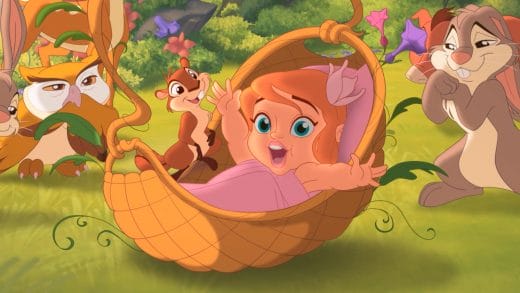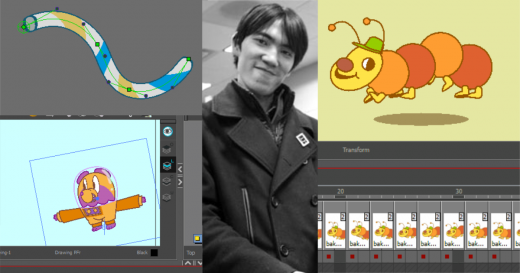
Mark Borgions runs his design studio, HandMade Monsters, in Antwerp, Belgium. Mark’s illustrations have been published in advertising, editorial, reference books and galleries around the world. He is also an accomplished independent animator — the music video HandMade Monsters brought to life for Stan Lee Cole’s Separated was nominated to over 20 film festivals worldwide, winning six awards.
Toon Boom selected Mark as a 2020 Ambassador in part for his impressive character rigs made using Master Controllers in Harmony. We first encountered the rig of the cyclops made for Heerlijk Hoorspel in October of 2019, which led us to interview Mark Borgions to understand what inspires his design practice, as well as his experience as an independent animator working with Master Controller rigs. You can read the full interview below.
Q: Did I look forward to learning the Master Controller in Toon Boom Harmony, since it seemed a bit complex.
A: No
Q: Did it turn out to be a lot of fun and easy
A: YES@ToonBoom #toonboomharmony #harmony #animation pic.twitter.com/LCTFMcGou6— Mark Borgions (@HandMadeMonster) October 1, 2019
What is HandMade Monsters, and what kind of work do you do?
HandMade Monsters is a one-man studio, specializing in illustration, design and animation projects. I come from a graphic design background, but always had an emphasis on illustration in my work. I make eclectic projects for very eclectic clients across the globe, yet I try to only take on projects that I can handle by myself. This means I rarely work in bigger production settings and practically only go out-of-house for my audio. These limitations afford me full control over the look and pacing of what I do.
{% video_player “embed_player” overrideable=False, type=’scriptV4′, hide_playlist=True, viral_sharing=False, embed_button=False, width=’1920′, height=’1080′, player_id=’27882552518′, style=” %}
Animation test provided by Mark Borgions / HandMade Monsters.
Your work tends to include flat colours, screen tones, and angular lines to great effect. Can you describe some of the influences behind your designs?
I’ve always had a tremendous love for the great designers of sixties and seventies: Saul Bass, Paul Rand, Milton Glaser and Maurice Binder. All of them did design work with a heavy focus on illustration, so that is no coincidence. Most of them did motion work too, so that was of great influence to me. I also have a soft spot for the limited animation aesthetics of Hanna-Barbera and UPA.
The imperfection and restrictive nature of old reproductions is something that also resonates with me. I don’t like things being too perfect. In my opinion, things that are less perfect tend to have more warmth to them. I look a lot at how paper, ink or filmstock ages. What it does to color and grain, that sort of detail. I am also fascinated with what limited budgets can do to big productions.
Put all of the above in a shaker, and you get something close to the work I do.
{% video_player “embed_player” overrideable=False, type=’scriptV4′, hide_playlist=True, viral_sharing=False, embed_button=False, width=’1920′, height=’1080′, player_id=’27882904524′, style=” %}
Rig preview provided by Mark Borgions / HandMade Monsters.
We enjoyed the cyclops character rig you made for Koning Odysseus. Can you tell us a little bit about this project and Heerlijk Hoorspel?
Heerlijk Hoorspel is a series of audio plays I make with two friends of mine, Paul Wauters and Koen Brandt. They’re adaptations of classic stories for children and their parents alike. Each are over 60 minutes, with a cast of about 15 actors, a fully orchestrated score and sound effects. They are marketed in picture books with a CD and downloads.
I do all the visuals for the series. So I illustrate the books, and toy around with the characters I create for marketing material.
The cyclops is a character from Homer’s Odyssey. I had wanted to learn to use Master Controllers for a while, so I did a simple rig and ended up using it for all sorts of communication. It was literally my first use of the Master Controller tools.
What was your experience like working with Master Controllers in Toon Boom Harmony?
I was a bit reluctant to try the Master Controller tools at first. My knowledge of scripting is very limited and I thought I would hit a wall before getting somewhere productive. It turned out quite the opposite.
Even with the limited projects I do, where characters are hardly ever reused, making a simple 9-pose controller takes very little time, yet helps the animation process enormously. As for the scripting, you hardly notice that part. I still have a few things on my wish list for the Master Controller, so I hope it keeps growing, but it’s already a game changer as it is now.
{% video_player “embed_player” overrideable=False, type=’scriptV4′, hide_playlist=True, viral_sharing=False, embed_button=False, width=’900′, height=’900′, player_id=’27882446034′, style=” %}
Rig demonstration provided by Mark Borgions / HandMade Monsters.
How long did the cyclops rig take you to make and refine?
The cyclops was a bit of a special character. Since he only has one eye, I did not have to deal with the usual problems that a pair of eyes can bring to a turning head. Also, this character had no nose. So having only an eye with a single brow, a mouth and a pair of ears made the head a lot less complex.
In all, I think the rig took no more than an hour or two, including the different mouth shapes and eyelids. Even with this being my first Master Controller rig, I only went back to it once to tweak things here and there before he was close enough to perfect.
What advice do you have for independent animators who are interested in experimenting with Master Controller rigs?
As the sneaker says: Just do it. Every time I use it now, I try to add something I hadn’t tried before to make it a bit more complex. It’s very easy to learn from working with it. I can see that when you have a big tv show pipeline, creating a rig can be an enormous task. For smaller projects, it really adds a great deal of control over your character, well worth the time it takes to make.
It’s not an all-or-nothing thing. You can use it for small functions here and there, and get great benefits from the effort.
{% video_player “embed_player” overrideable=False, type=’scriptV4′, hide_playlist=True, viral_sharing=False, embed_button=False, width=’1080′, height=’1080′, player_id=’27882552677′, style=” %}
Animation test provided by Mark Borgions / HandMade Monsters.
Do you have any final thoughts for our readers? What else should they know about HandMade Monsters?
I really see animation as a moving variant of my illustration. So when I present to a client for the first time, I prefer to present ‘final look’ over storyboards or animatics.
For example, I make the first two, three shots and put them through the complete pipeline. This means that when I present the film for the first time, they have a good sense of what is to follow. I have learned that it helps me get my client’s trust. And once I have that, they trust me with most of the decisions I make. (I do make storyboards and animatics, but seldom share them with the client.)
I also want to be allowed to work with the script. Most of the scripts I get are way too all-bases-covered. I want to be able to strip it to the core, and make sure the audience stays with the message. In that way, there’s really a lot I’ve learned from making the audio plays.
Want to keep an eye on Mark Borgions’ work? You can find his portfolio at HandMade Monsters and follow his #twocolorcharacter illustrations on Instagram.



